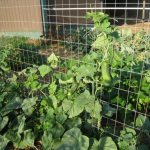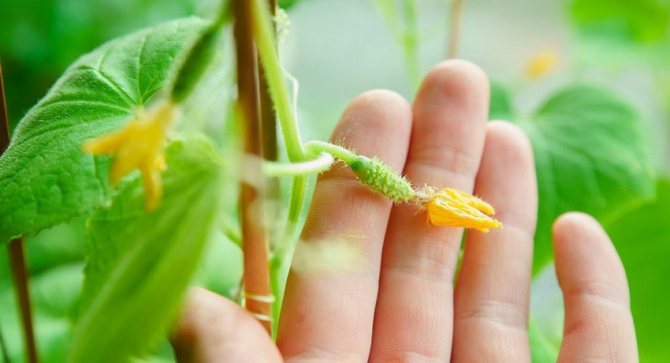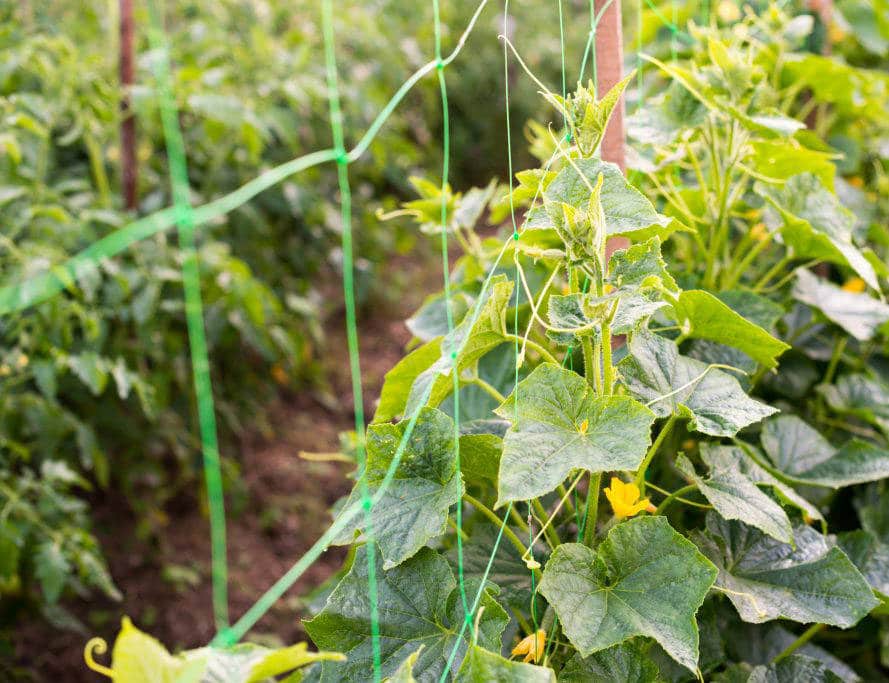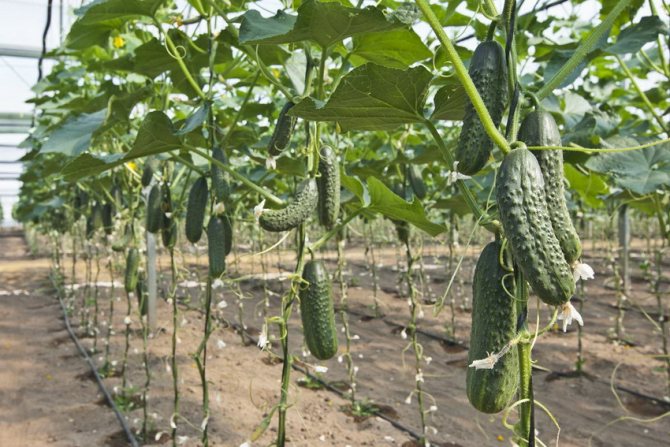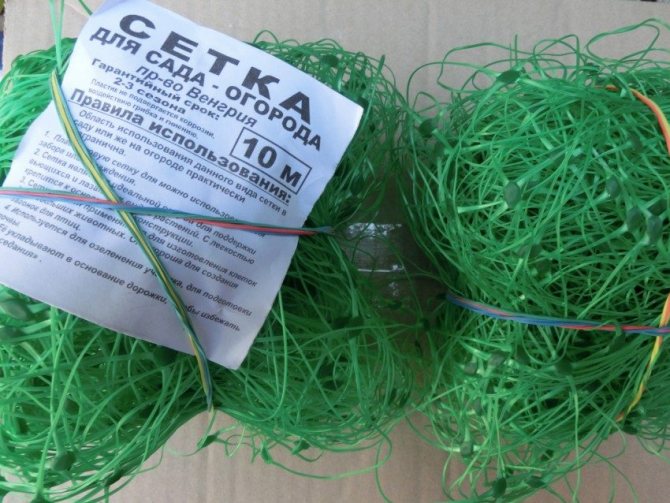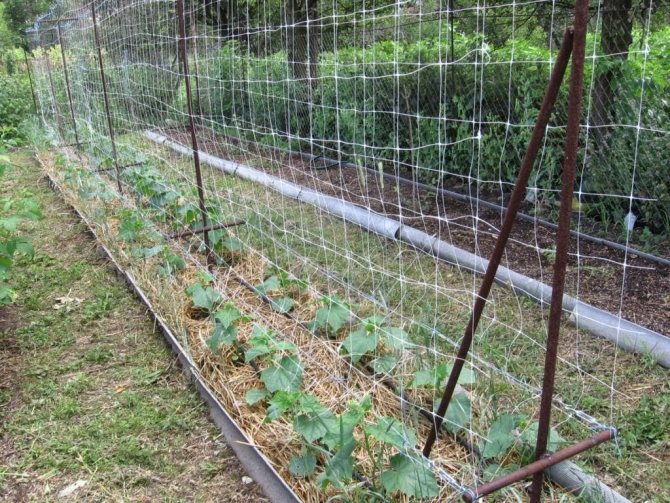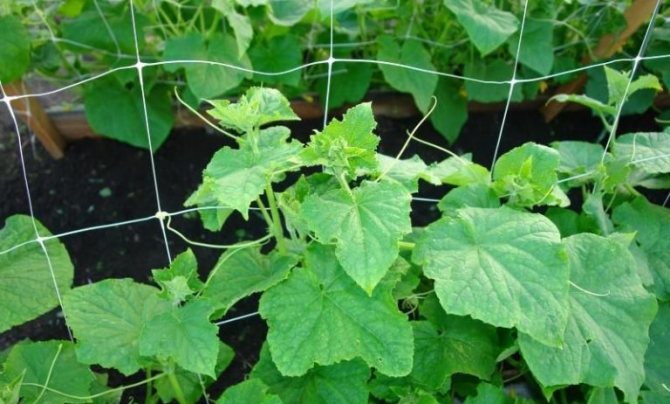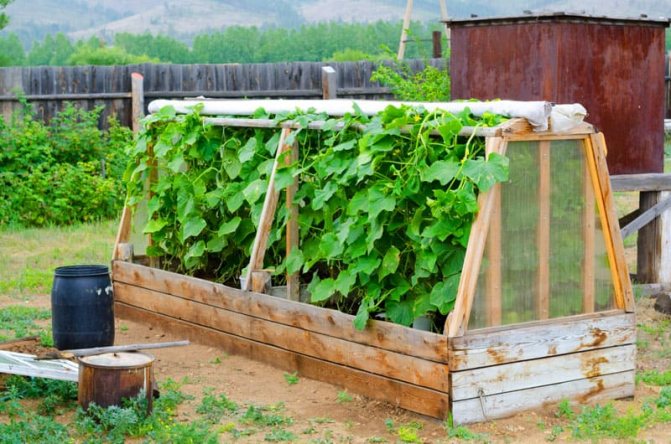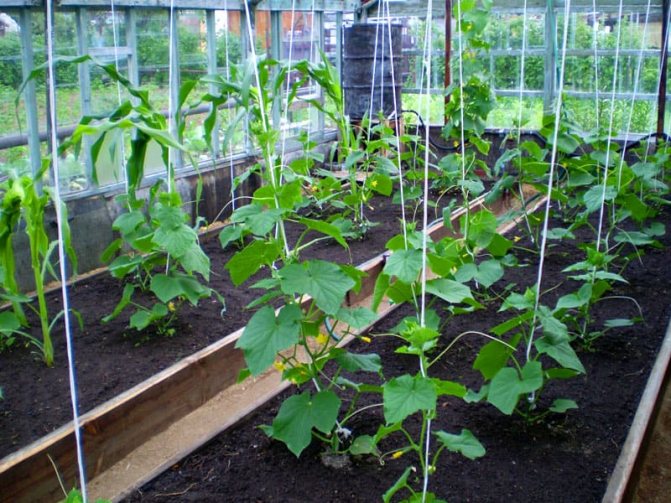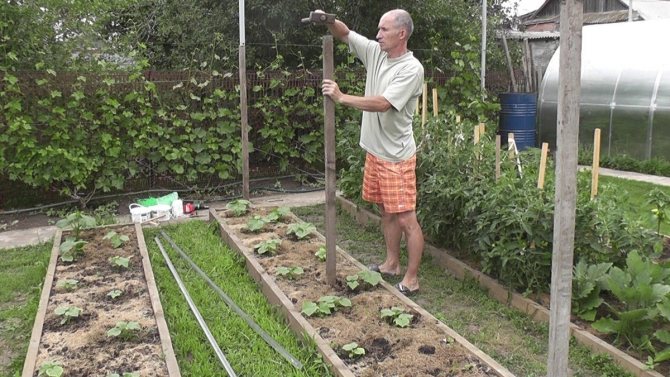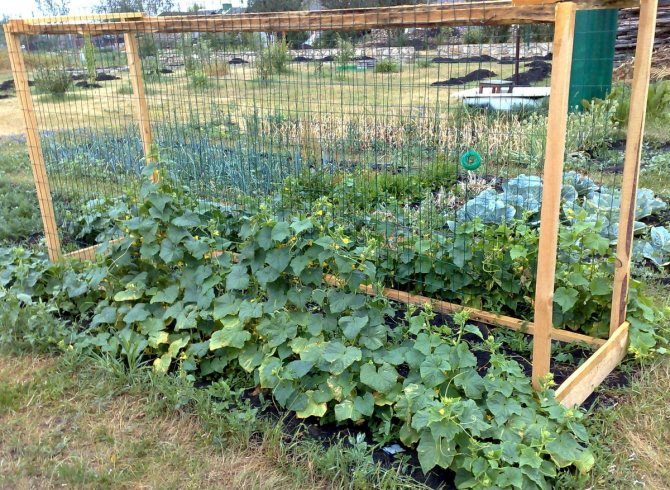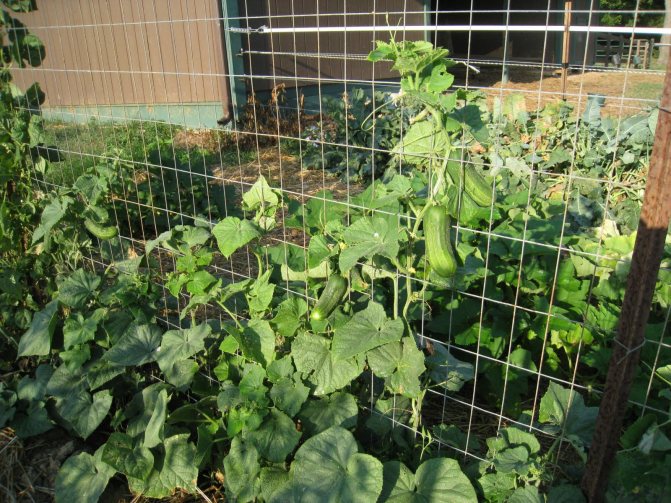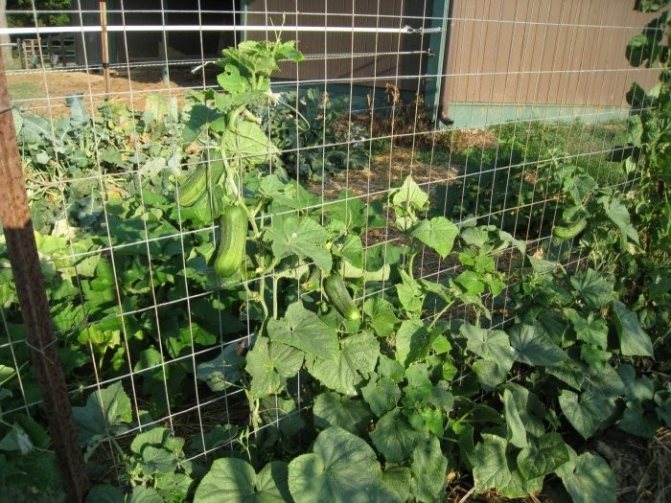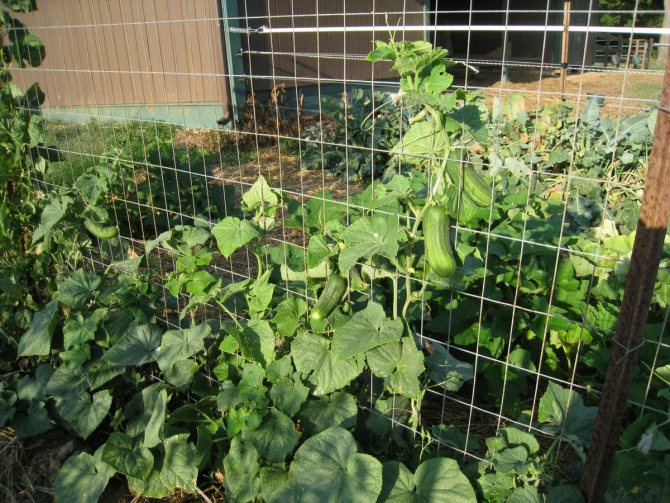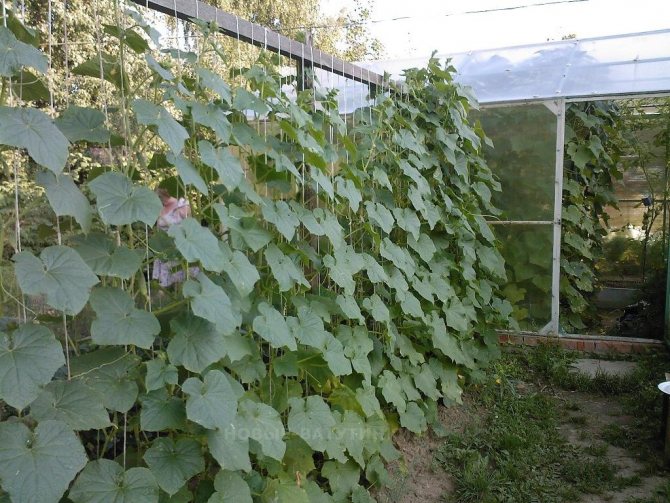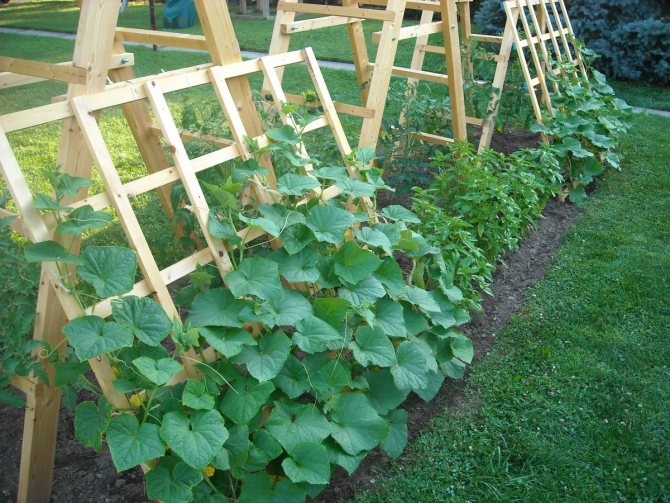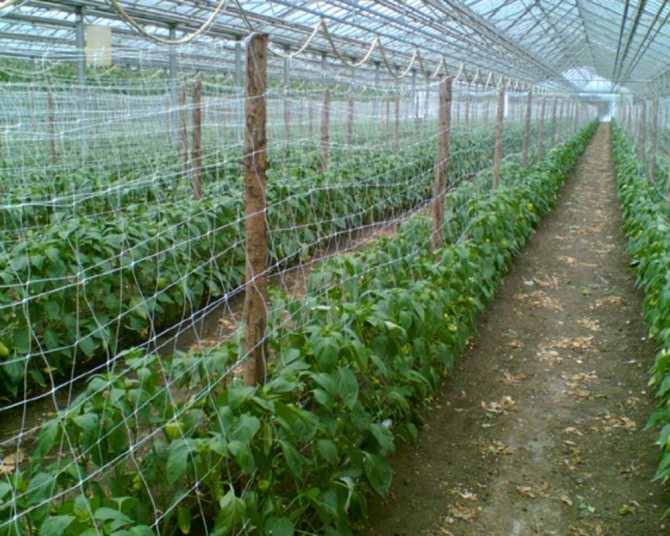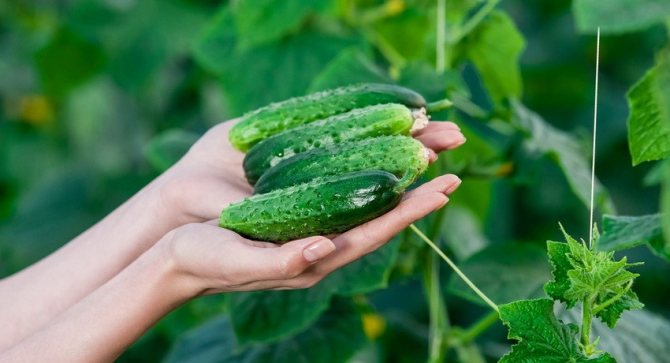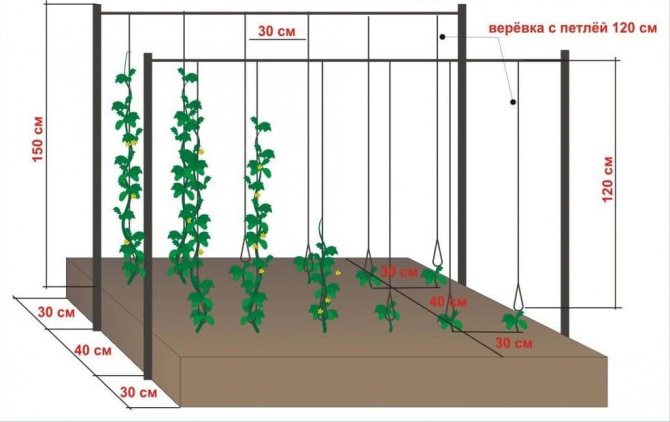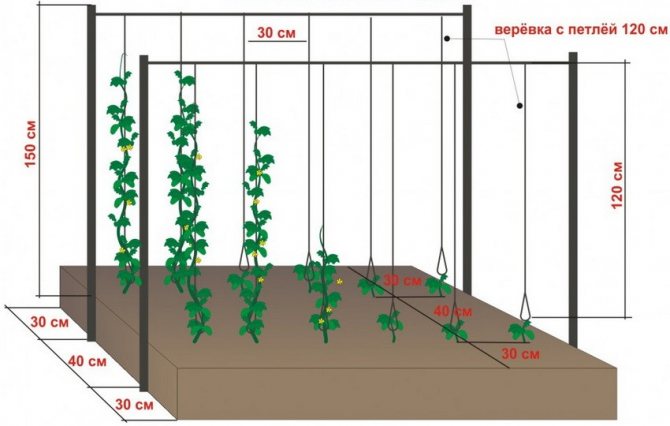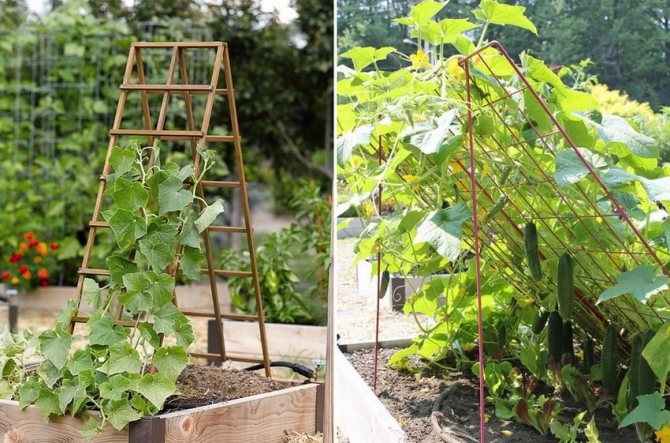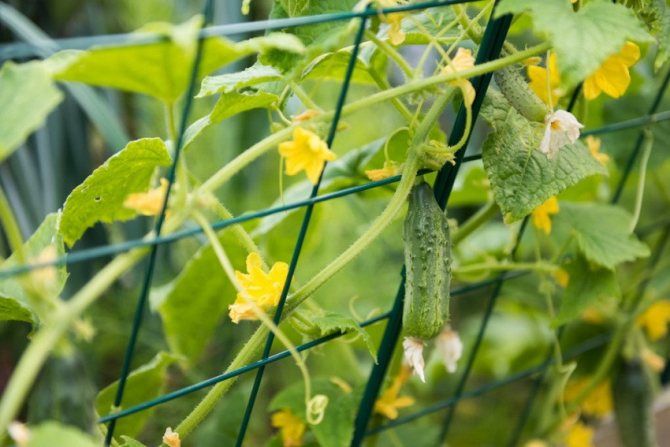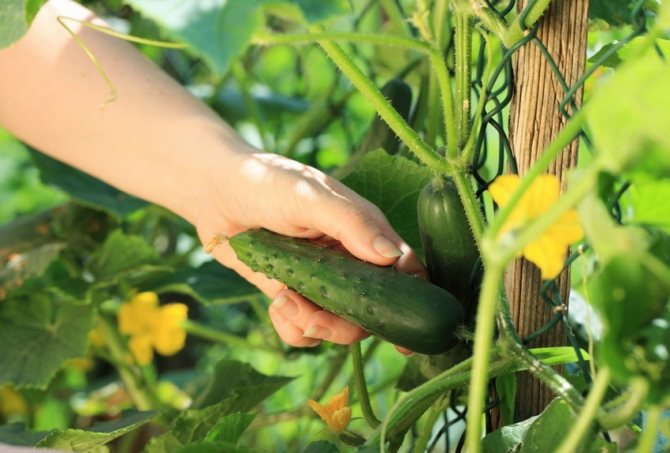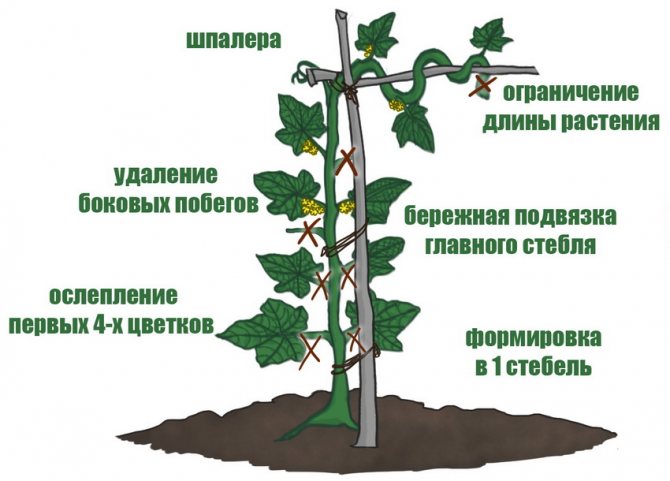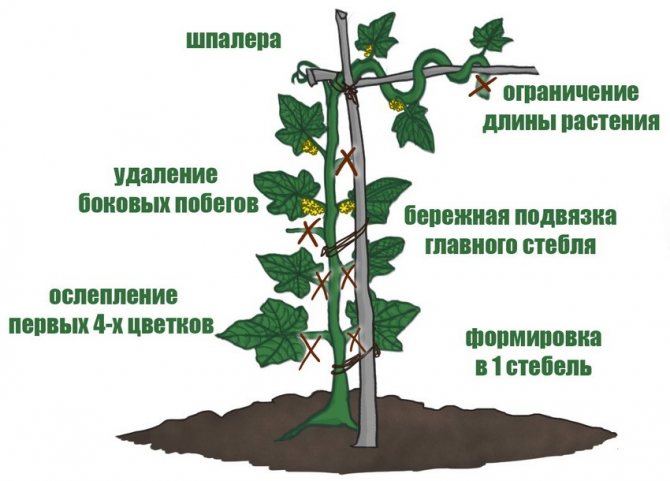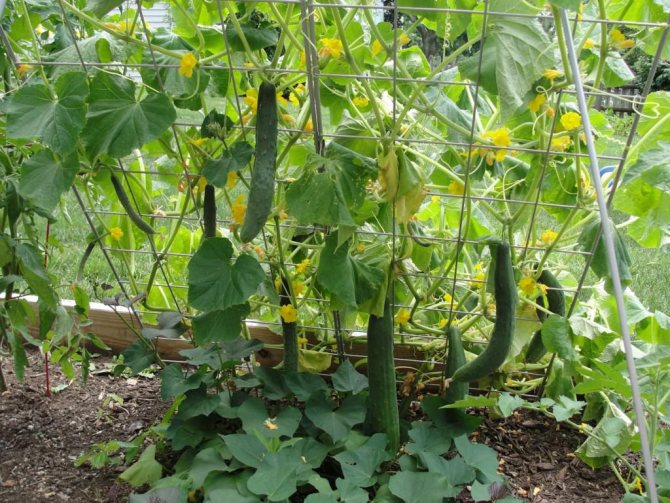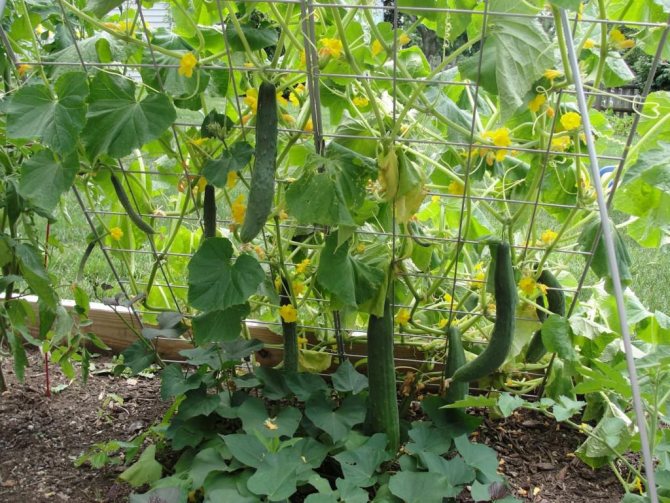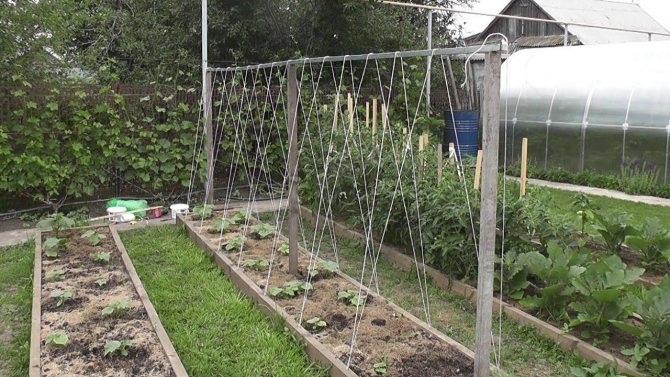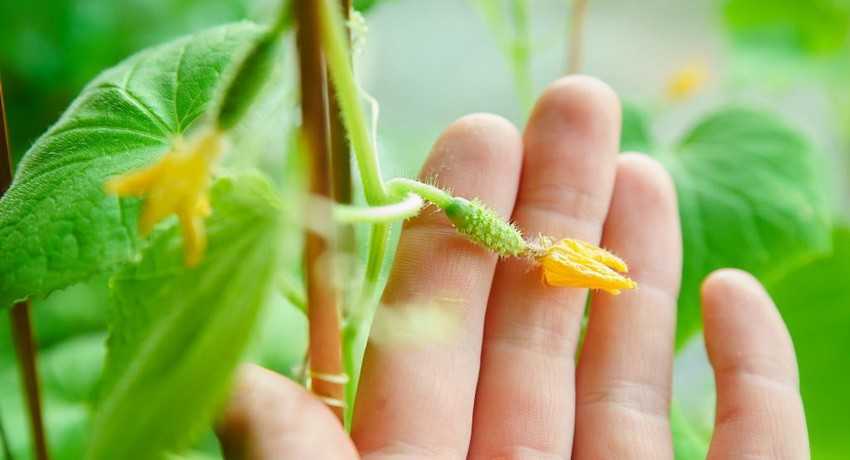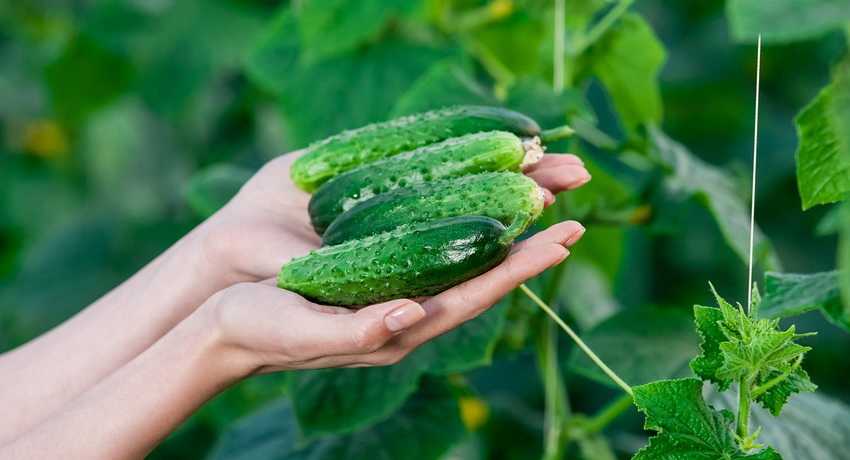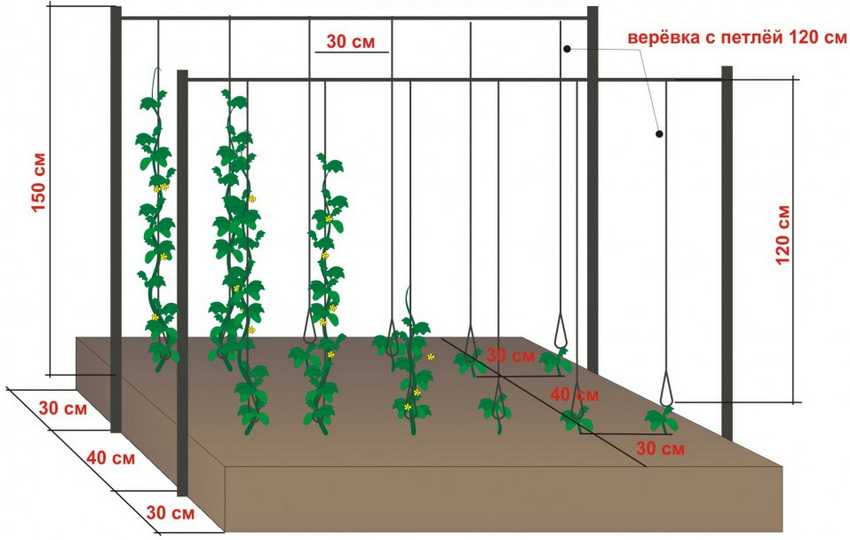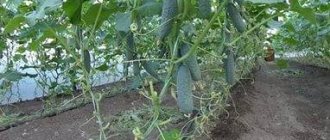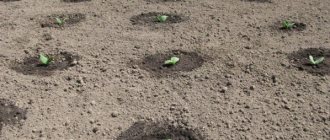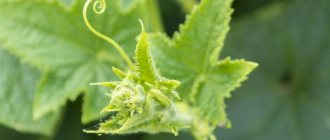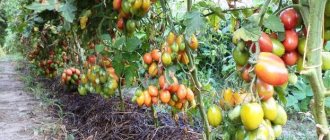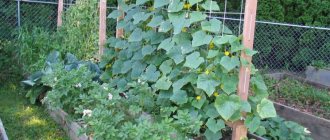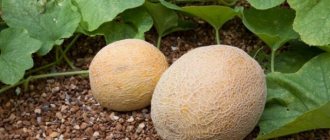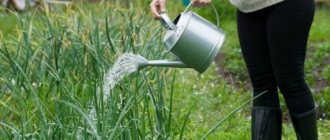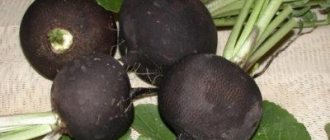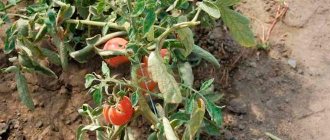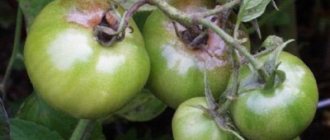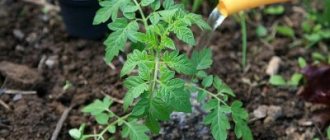Benefits of its use
Trellis structures for growing cucumbers are installed both in the greenhouse and in open areas. Thanks to the mesh canvases, it is much easier to grow vegetables, and cut off bushes, and collect fruits.
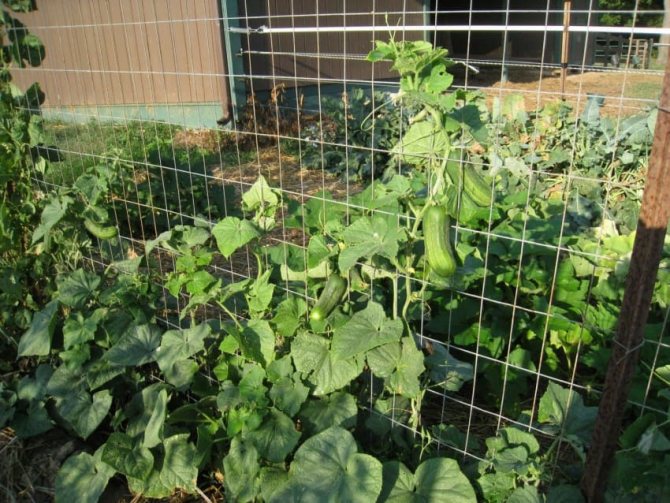
In the greenhouse
The mesh cloth is especially convenient for use in large greenhouses. The time for the construction of the trellis is significantly reduced, it is easy to tie up the plants.
In addition, there is no need to dig in additional supports - the mesh can be tied to the greenhouse frame.
In the open field
With the trellis method of growing plants in the garden, you have to devote time to the installation and dismantling of the structure. However, the positives cannot be underestimated:
- the land is used rationally;
- plants are well lit, ventilated;
- yield increases;
- the likelihood of disease in bushes decreases;
- there is practically no loss from fruits lying on the ground.
Advantages and disadvantages of artificial mesh
The use of a net in the cultivation of cucumbers has its advantages and disadvantages.
The benefits of a mesh include:
- Saving space. This is true in small areas and in greenhouses, when it is necessary to harvest from several varieties of vegetable crops in a limited area.
- Support for growth. Cucumbers in the process of development have the ability to cling to the tendrils of the net, which ensures their normal growth.
- Prevention of cucumber diseases. Fungal diseases often develop in a humid environment, when the roots and aerial parts of cucumbers are inaccessible for air blowing. The grid ensures that the cucumbers are positioned in such a way that aeration is at a high level.
- Convenience for agrotechnical activities. Ordered beds are accessible from either side. This makes it easier and more efficient when feeding, loosening, watering and other work. The fruits are visible, which guarantees their high-quality collection, prevents overripening.
- Optimal conditions for development. Plants do not touch each other, and vines do not intertwine. There is enough sunlight for each leaf and fruit. There is no competition, which causes stress in the vegetable crop and leads to the appearance of bitterness in cucumbers, reduces the overall yield.
- No mechanical damage to fruits and plants. Vertical cultivation ensures that the whole fruit ripens, protecting it from damage by animals, insects or accidental damage during harvest. In addition, cucumbers are protected from contamination, as they do not have contact with the ground.
- The aesthetics of the beds. Beautiful well-groomed beds are pleasing to the eye and envy of neighbors.
There are no obvious drawbacks to the use of a cucumber net. Rather, these are small nuances:
- Obligates to water the area more often.
- The vertical placement of cucumbers shades the surrounding area. This problem can be solved by planting shade-loving garden crops at the base of the beds.
After the end of the season and the harvest of cucumbers, it is recommended to roll the cucumber net and store it until spring. This will limit the impact of the external environment on the material of the product and preserve its operational properties.
Varieties and methods of installation
Most cucumber varieties have long, branchy stems.The use of various support nets will facilitate the care of the green mass of the vegetable.
Plastic
The canvas is highly durable and can become a worthy alternative to the metal "chain-link". Unlike the soft cucumber trellis net, the plastic one can be used as a decorative fencing for front gardens, sports grounds, aviaries for poultry. Beautiful sheds, gazebos, green arches are erected from the garden lattice. They produce products with cells ranging in size from 5 to 15 cm.
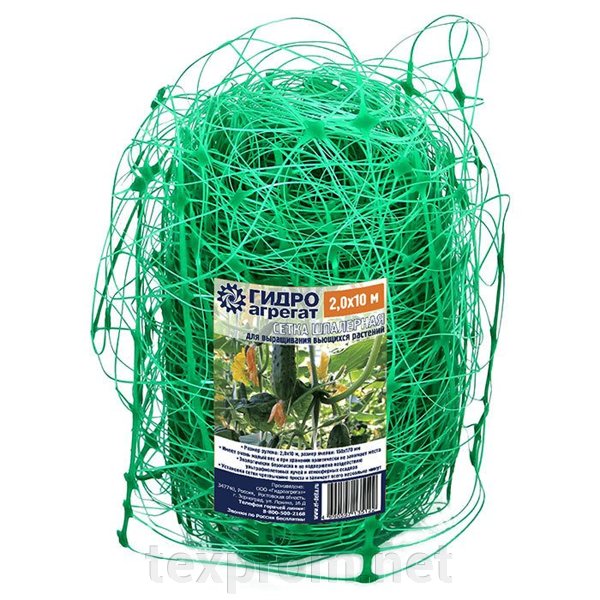

Metallic
The blade is reliable and capable of supporting the weight of any vegetable harvest. The canvas weighs a lot, so it is used when arranging permanent fences or trellises. The disadvantages of the material are cost, susceptibility to erosion. To extend the service life, you can paint with a special paint. Sell steel nets, galvanized, plastic coated.
See also Harvest and Popular Polycarbonate Greenhouse Cucumbers


Trellis
Such materials are most in demand for arranging trellises, since they are practical and have low weight. Suitable for growing cucumbers in a greenhouse or open field. You can install the trellis in different ways.
Vertical structures
An excellent choice for the construction of supports in long beds, in greenhouses, when growing indeterminate varieties of cucumbers. Metal pipes and wooden posts are used as racks.
The mesh is pulled between the supports with a height of 2.0-2.5 m. To prevent the canvas from sagging under the weight of the bushes, a U-shaped structure with additional supports is installed.


Inclined
The installation of such tapestries takes a little longer. The canvas is not placed vertically, but with a slope. Moreover, the angle of inclination is determined by the variety of cucumber. When planting low-growing plants, a sufficient angle of inclination is 35-40 °. The design is suitable for arranging cucumber beds, planted under a fence or against a wall.
A-shaped
Many gardeners practice two-row planting of cucumbers. The principle of arranging the structure: a pair of supports are installed along the edges of the beds, the tops of which are connected. The crossbar is fixed on the supports. The canvases need to be pulled in such a way that the structure looks like a hut.
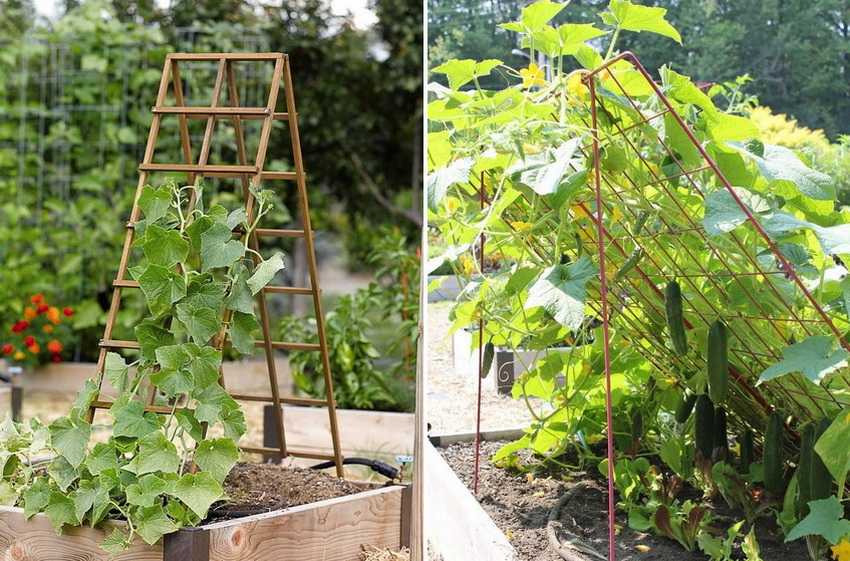

Arched
Quite sophisticated structures most often perform a decorative function. Arched trellises originally decorate paths and gazebos. Many summer residents plant cucumbers instead of climbing plants.
Recommendations for making mesh
Making a grid for cucumbers with your own hands is not at all difficult. There are a number of factors affecting how much time will have to be spent on its manufacture: the materials used, the size of the site. When pulling a structure on a bed, the length of which is less than 10 m, it is advised that it be fixed more securely, put 3 wooden or metal supports. If the net for cucumbers is pulled in a greenhouse, you need to install 2-3-meter posts. To fix the mesh fabric, you should put several rails, the length of which is about 5 m. It should be weaved from a very strong wire.
The simplest design can be made by pulling a thin (2 mm) wire between the supports. Weave it horizontally in several rows. It will become improved if you put a beam between the posts, from which you vertically lower as many cords as you need. The cords are pulled by tying a hook to the ends, which is deepened into the ground.
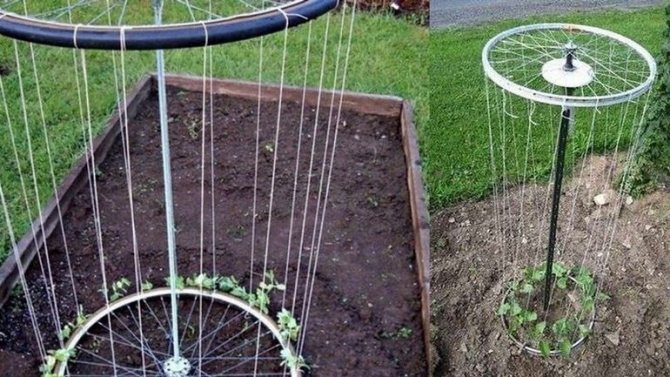

Some gardeners use old car tires and bicycle rims as unusual trellis options. The split tire is placed on the ground. A pillar is dug into the center - a support. A rim is attached at the top, and a rope is threaded through the holes into which the knitting needles are inserted. It is attached under the tire. It is necessary to pour soil inside the tire and plant seeds.
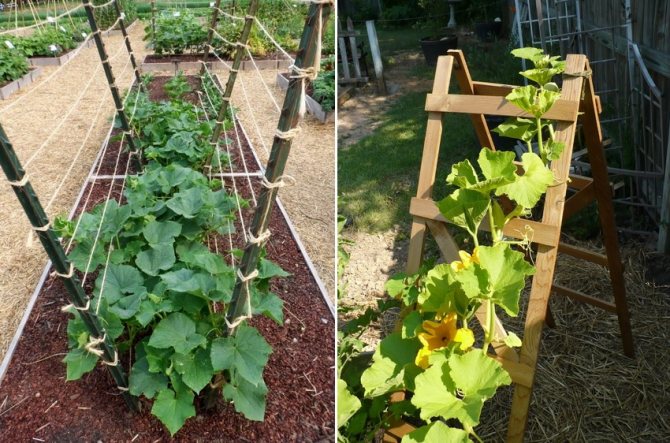

Many gardeners install trellis structures on the beds.At the heart are racks and mesh weaving. A plastic net specifically designed for plants that curls is on sale today. Although you can use twine, wire or rope. Supports can be:
- pipes made of plastic or metal;
- fittings;
- thick branches;
- concrete pillars;
- wooden bars.
A high-quality do-it-yourself net can be used in a greenhouse and open field for several seasons.
How to weave a grid for cucumbers with your own hands?
It is not difficult to make a mesh support for cucumbers yourself. You will need a standard set of materials: support posts, rope. Stages of work:
- Low pillars are dug in along the edges of the beds.
- Several parallel rows of rope are fixed between the supports with a step of 10-15 cm.
- The horizontal rows are additionally intertwined with a rope vertically (the size of the cells is chosen arbitrarily).
- Low horizontal trellises are convenient to equip along short beds with weaving vegetables.
Gardeners reviews
Natalya Gennadievna, Moscow Region Five years ago I bought a garden plot. Previously, I did not come across growing vegetables, so I grew cucumbers in the old fashioned way - the stems were dragged along the ground and watering, harvesting took a lot of time. Last year I saw trellis structures from neighbors and this season I also equipped a small horizontal trellis 2 m long. I planted early-ripening cucumbers of the Masha variety and it was a pleasure to harvest. It is wonderful that it was much more comfortable to care for the bushes.
Boris, Belgorod I have long been a supporter of cucumber tapestry cultivation. I experimented with designs of different types, but I stopped the choice on a hut-like one. I make the supports from the branches - it turns out that money is saved and the sawn branches are used.
Previous
CucumbersHow can you feed cucumbers during flowering and fruiting
Next
Cucumbers How to pinch cucumbers correctly in the greenhouse, open field and on the balcony
How is the process of tying bushes
It is not enough to install a trellis structure on a cucumber bed. It is also important to fix the stems correctly. Plants need a garter, the stems of which have grown 15-20 cm long. Each bush is attached to a mesh support using a rope or a strip of fabric. Do not tighten the loop tightly as the stem will still grow.
Important! After the appearance of lateral shoots, they begin to form bushes, all new stems are also neatly tied up.
See also the Characteristics and cultivation of Murashka cucumbers
Build process
To understand how to make a mount and how to install it on a site, you need to familiarize yourself with the features of the assembly of the structure. At first, assembly and installation can seem like a pretty daunting job. However, if you understand the basic installation recommendations, then everything becomes much easier.
To begin with, it is necessary to install 3-4 strong pillars in the ground with a height of at least two meters.
The distance between the supports made should be about 5-6 meters. Their base is fixed very securely so that the supports do not stagger during cultivation. Therefore, all the supports are planted in the ground to a depth of about 50-85 cm. In the upper half of the pillars, with the help of nails, slats are mounted, to which the tied bushes with a net will be attached.
The fastening mesh is pulled last. At the same time, it must be tightened and secured very reliably so that in the future it does not detach from the supports with rails.
The specifics of caring for cucumbers on the grid
Cucumber care can be divided into several stages. First of all, it is important to water the bushes correctly: warm water is poured onto the floor by the root, avoiding contact with the leaves. Irrigation is carried out in the evening or in the morning, the slightly dried soil must be loosened or covered with mulch (straw, hay).
When forming a bush, the stems and shoots are pinched to stop the growth of the central stem, to stimulate the appearance of lateral lashes.So that the procedure does not harm the plant, it is necessary to take into account the rules for pinching different varieties of cucumbers.
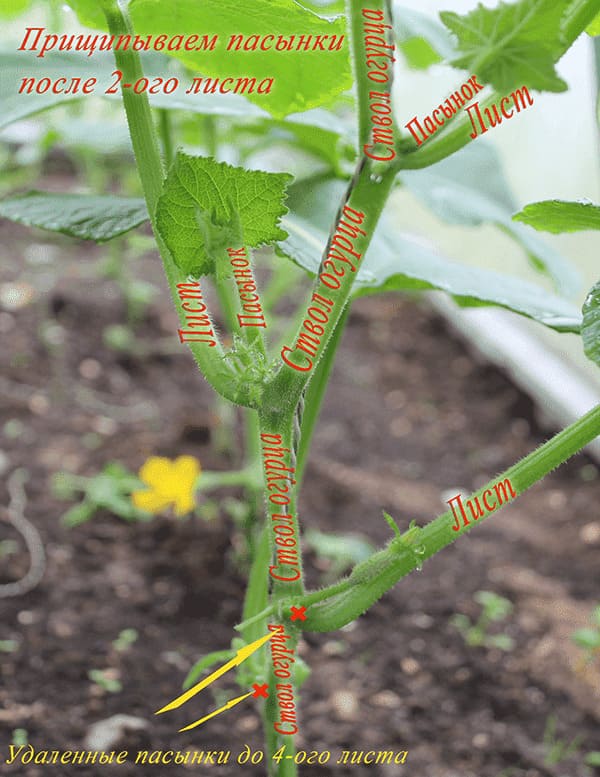

Classic mesh
We find out from what elements the classic trellis mesh is arranged:
- support
- the mesh itself
- mounts for her
In order to give the structure stability, a metal support, wooden beams or pillars filled with cement are used. As for the net, it is made of wire, rope, twine or plastic. You can also use a ready-made solution by purchasing a PVC mesh, it can be purchased in specialized shops with gardening goods.
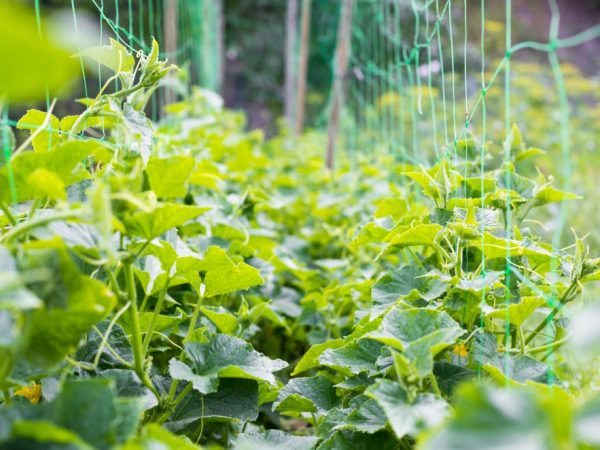

You can buy a ready-made PVC mesh
The net is fixed from above to posts or other support, while the bottom edge is placed in the ground, while securing it with wire hooks for better strength.
Further we will talk about what other options for making cucumber trellises exist, we will give the most common methods.
Tips and Tricks from Experienced Gardeners
It is recommended to plant highly branching varieties in a row with a step of 45-50 cm. On two-row beds, the distance between the rows is 40-50 cm, and between the beds - 80-90 cm.
In order not to expose the root system of plants, it is better to water the bushes from a watering can. The best option is to install a drip irrigation system.
In cool weather or towards the end of summer, the frequency and volume of watering is reduced, since the cold, moist soil stimulates the development of root rot.
Be sure to follow the rules of crop rotation. Therefore, it is advisable to install light trellis structures, which will be easy to transfer to other beds.
Agrotechnics of cucumbers on a trellis
Agrotechnology of cucumbers on a trellis includes:
- the correct choice of predecessors (crop rotation);
- soil preparation;
- sowing or planting;
- fertilization;
- garter to the trellis;
- plant formation;
- harvesting.
Predecessors
It is best to plant cucumbers in areas where they used to grow:
Slightly less suitable are:
- legumes (excluding beans);
- early potatoes;
- root vegetables (beets).
Photo Gallery: Suitable Precursors for Cucumbers
Soil preparation
It is advisable to arrange the beds for planting cucumbers on a trellis from east to west so that the plants are well lit throughout the day. The width of the beds for a single-row planting should be 40–45 cm, and for a two-row planting - 70–80 cm. The soil for cucumbers is prepared in the fall:
- dig up the selected area;
- 5-6 kg of manure, 30 g of superphosphate, 200 g of ash or dolomite flour are applied per 1 m²;
- the soil is leveled so that water does not accumulate in one place.
In the spring, before sowing seeds or planting seedlings, the earth is disinfected with a hot dark solution of potassium permanganate. If the cucumbers are grown from seed, the trellis can be set before sowing or later, when the first pair of true leaves has formed on the sprouts. If the seedling method is used, the trellis is installed before planting the plants.
Landing scheme
Seeds or seedlings are placed on the garden bed in 1 or 2 rows along the trellis. Landing scheme:
- between plants in a row - 15–20 cm;
- between rows - 15–20 cm;
- between parallel trellises - 80-100 cm.
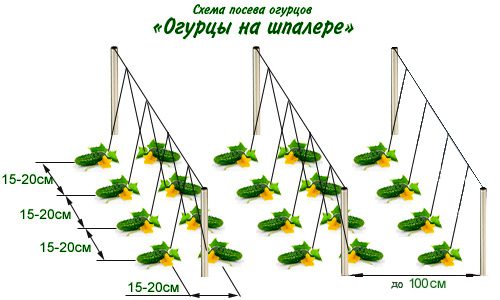

The scheme of planting cucumbers on trellises assumes a distance between bushes and rows of 15-20 cm
Top dressing
During the season, 4 dressings of cucumbers are carried out:
- with the seedling method - 2 weeks after planting on the garden bed, and with the sowing method - after the formation of the 5th leaf on the seedlings;
- when the first flowers appear;
- during the ripening of the bulk of the fruits;
- 20 days after the third feeding - to extend the growing season.
Depending on the fertility of the soil and his preferences, each gardener selects the composition of fertilizers he needs.
All solutions of organic and mineral fertilizers for root dressing are used in a volume of 1 / 2–1 l for each plant.
To prolong fruiting, cucumbers are fertilized with organic matter - 1 part of the herb infusion is diluted with 5 parts of water, using 1 / 2-1 l for each plant, or in the same volume with a solution of one of the minerals in water (10 l):
- 25-30 g of baking soda;
- 200 g of ash.
Foliar dressing is carried out with a urea solution (15 g per 10 l of water).
If the land on the site is fertile, the cucumbers are fertilized only 2 times: 2 weeks after planting and to extend the growing season during the fruiting period.
Table: options for organic fertilizers for the first feeding
| Name | Concentration (kg / l of water) |
| Fresh bird droppings | 1/15 |
| Slurry | 1/8 |
| Cow or horse manure | 1/6 |
| Infusion of green herbs | 1/5 |
The preparation of fertilizers from poultry manure and manure consists of stirring these substances in water, the herb infusion requires a little more effort:
- Fill the container (preferably non-metallic) with cut grass, weeds or hay.
- Seal.
- To fill with water.
- Press down on the grass with a load so that it does not float.
- Cover with a lid or cloth.
- Leave to ferment for 1-2 weeks. Fermentation produces an unpleasant odor that will disappear when the process is complete.
- Then dilute 2 liters of herb infusion in 10 liters of water.
Video: cooking herb infusion
Table: options for mineral fertilizers
| Fertilizer name / options | Urea (g) | Superphosphate (g) | Ammonium nitrate (g) | Potassium salt (g) | Ammophos (g) |
| I for 10 liters of water | 30 | 60 | |||
| II for 10 liters of water | 10 | 10 | 10 | ||
| III spread over 1 m² and close up by loosening | 5 |
Table: options for the second fertilization with mineral fertilizers
| Fertilizer name / options | Potassium nitrate (g) | Superphosphate (g) | Ammonium nitrate (g) | Ash (g) |
| I for 10 liters of water | 20 | 40 | 30 | |
| II for 10 liters of water | 200 | |||
| III spread over 1 m² and close up by loosening | 30 | 200 |
The second time you can feed the cucumbers both under the root and by spraying.
Table: foliar feeding options
| Fertilizer name / options | Superphosphate (g) | Potassium permanganate (g) | Boric acid (g) | Sugar to attract pollinating insects (g) |
| I for 10 liters of water | 35 | |||
| II for 1 liter of water | 0,5 | 7 | ||
| III 1 L | 2 | 100 |
Foliar dressing is carried out - the leaves are sprayed on both sides.
Table: options for the third fertilization with mineral fertilizers
| Fertilizer name / options | Potassium nitrate (g) | Urea (g) | Ash (g) |
| I for 10 liters of water | 25–30 | ||
| II for 10 liters of water | 50 | ||
| III 1 L | 200 |
The third time the cucumbers are fertilized:
- organic matter - 2 liters of herb infusion per 10 liters of water.
- spraying - 10-12 g of urea per 10 liters of water.
Garter cucumber
How the cucumber lashes will be fixed on the trellis depends on its design:
- with vertically stretched twines - the whips are twisted around the twine in a clockwise direction;
- with horizontal strips or wires - the stems are fixed with strips of fabric so that they are not pinched;
- with a peg for each plant - make a loop of dense fabric or soft plastic (a piece of a plastic bottle), which is used to grip the stem and support, and the ends of the loop are fixed with a stationery stapler;
- with a mesh stretched between the supports - the cucumbers themselves are fixed with a mustache.
Video: garter cucumbers
Formation of lashes of cucumbers on a trellis
The main formation technique is pinching (removing) the growth point of the lateral shoots or the main stem. This operation is carried out constantly - once every 7-10 days throughout the growing season. In the descriptions of cucumber cultivars, it is necessary to indicate on which lashes (lateral or main) the formation of female flowers occurs.
Cultivar is a botanical term that combines the concepts of cultivar and hybrid.
Varietal plants most often form fruits on lateral shoots, and hybrid ones - on the main stem. There is a general rule of formation for any cucumber cultivars: up to 3-4 leaves, remove all leaves, side shoots, whiskers and fruits. This speeds up the development of the main stem and protects the plant from disease, as ventilation is improved and the leaves do not come into contact with the soil.
On the main stem of varietal cucumbers, after the 6th leaf, the growth point is removed, which accelerates the formation of lateral shoots (stepchildren).
In the future, stepchildren of the second order grow on these stems, on which the crop is formed. Stepchildren of the third order pinch after the first leaf, under which the ovaries have formed. On stems above 1 m, 2 leaves with ovaries are left on the stepsons.When the stems reach the upper edge of the trellis, a growth point is removed from each lash or directed horizontally (all in one direction).
Hybrid cucumbers bear fruit on the main stem. They are formed into one stem, removing all stepsons. When the lash reaches the top of the trellis, 2 stepsons are left to prolong the fruiting period.
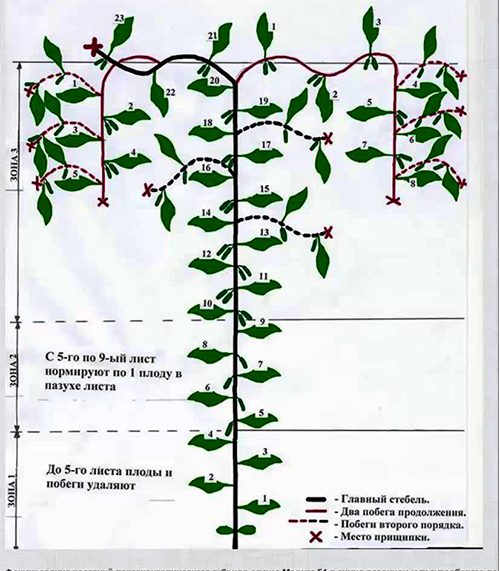

Hybrid cucumbers form on one stem
It is very simple to distinguish varietal cucumbers from hybrid ones - varietal cucumbers have the first flower without an ovary, and hybrid ones with an ovary (female).
Video: an interesting way to form cucumbers
Video: forming cucumbers into one stem
Harvesting
Cucumbers are harvested every day or at least once every 2 days in the morning or in the evening, otherwise the formation of new fruits slows down. What size of greens to collect is determined based on the form in which they will be used:
- pickles - 5 cm;
- gherkins - 5-9 cm;
- pickles - 9-10 cm;
- fresh - 10-14 cm.
It is necessary to collect not only healthy cucumbers, but also damaged or deformed ones. Then the plant will not waste energy and nutrients on defective fruits.
More and more gardeners prefer to grow cucumbers on a trellis. The main advantage of this method in comparison with the traditional one is the facilitation of plant care at all stages of the growing season.
Growing features
To obtain the maximum yield, you will need a properly prepared soil and planting seedlings.
- The onset of autumn means the beginning of work on digging a ditch, the depth and width of which reaches 60 cm. Its duration coincides with the length of the trellis;
- Next, you should prepare a mixture of fertilizers such as chicken manure, goat, cow and horse manure, as well as ash (in proportions 1: 3: 6: 6: 3). With this mixture, fill the ditch to the top, then sprinkle it with earth and form a bed;
- During the duration of the winter period, rotting of manure and a decrease in the beds will occur. With the onset of spring, one should proceed to the stage of digging a new ditch in the same place at a depth of 10-15 cm and planting seedlings, taking into account the 20-centimeter distance from one plant to another;
- To preserve the looseness of the soil for cucumbers, it is necessary to use dry leaves or straw as a covering material;
- With proper watering of seedlings, warm water should only fall under the root of the plant;
- As soon as the cucumbers reach the desired height, they should be guided to the top along the net with their own hands and, if necessary, carry out a garter;
After watching the video, you can correctly complete the process of planting seedlings and caring for the crop for the entire duration of their growth and development.
When using this method, you can achieve a large yield. Such trellises will become indispensable helpers in the process of growing other crops, such as tomatoes, climbing flowers, raspberries and blackberries.
Also, the trellis structure does not require much effort in the do-it-yourself assembly process and can be disassembled in a short time.
During the growing season, cucumbers grow rapidly, occupying a significant area on the site. Vines intertwine with each other, which negatively affects the formation of fruits and complicates the care of the vegetable crop. In this case, a cucumber net will come to the aid of the gardener. With it, it is possible to grow cucumbers using the vertical method, which provides a lot of advantages. It is only important to choose the right mesh and install it.
Tying cucumbers to a support vertically: method description
In this case, two supports must be placed on opposite edges of the bed, and at the very top between them you need to pull the rope. We tie fabric strips 2-3 cm wide along the entire length of the stretched cable and lower them down. Their number should be equal to the number of bushes that need support. Tie the bottom end of the fabric around the base of the cucumber.
As a result, the plant will independently cling to the support and stretch upward along it. This method makes it possible to arrange a large number of cucumber bushes in a small area. Instead of fabric strips, sticks are often used placed near each plant. You can also make a triangle of three supports, and between them pull the ropes and hang the support strips.
Made of metal
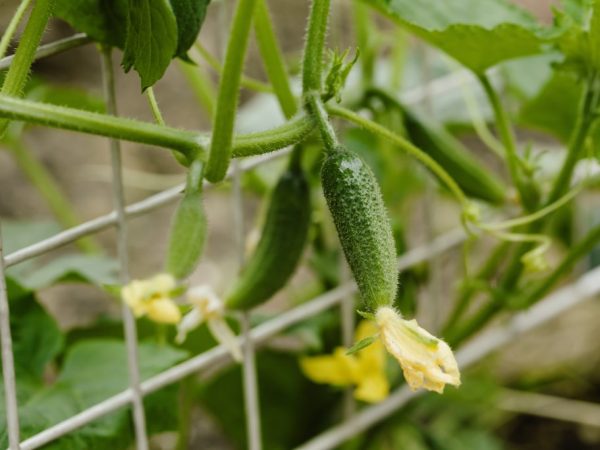

Metal trellis mesh will last for many years
Compared to the previous design, metal requires more expensive materials, more time and, of course, more effort. However, all costs will be paid off by the fact that the service life of such a product is much longer than that of a wooden trellis.
Materials required for construction:
- Reinforcement - length of rods about 2 meters
- To equip the crossbeam - the pipe is thinner
- Pegs for driving into the ground
- Welding machine
- Wire
- Drill for earth
- Hammer
Stages of work
First, you need to make a markup, mark the places on the ground where the racks will be located. After you have decided on the place, use a garden drill to drill holes at least 40 cm deep.When the work is done, place the metal rods in the recesses, it is recommended to help yourself with a hammer to drive the rod as deep as possible. If voids have formed around them, fill them with earth.
To prevent the metal from undergoing the natural rusting process, it is recommended to pre-treat all metal elements with oil paint or a solution against metal corrosion.
After the frame is ready, we move on to the next stage - the construction of the canvas for weaving the mesh. The best option for making it would be a metal wire, it needs to be pulled between the pegs and the crossbar. The pegs are located at a certain distance - about 20 cm. In order for the structure to serve as long as possible, it is recommended to purchase a wire with a diameter of at least 3 mm. In addition, it is better to weave in several rows, place the first row at a height of about 20 cm, then go down 50 cm and so on to the very bottom.
It is worth considering that the metal trellis is heavy, so moving and reinstalling it can become quite difficult to complete the task. In order to improve crop rotation, you can alternate growing cucumbers on a trellis with planting peas or beans on a grid.

